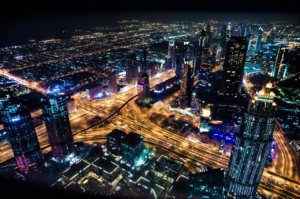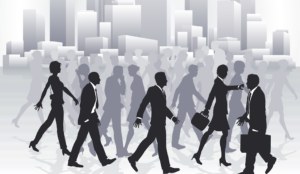“Future cities, where infrastructure adapts to our needs, are an enticing prospect,” writes Dr. Gary Graham, a Lecturer in Operations Management at the University of Leeds. “But,” he asks, “who is in the driving seat as these urban developments crop up around the world? We need to make sure that the people who will actually live in these cities benefit.” [“Is anyone asking people what they want from the smart cities of the future?” The Conversation, 11 March 2014] Graham’s question is applicable to both to so-called greenfield cities (i.e., new cities developed from the ground up to house a burgeoning urban population) and to brownfield cities (i.e., extant cities with established roads, electrical grids, water and sanitation systems, etc.). We know that big IT companies are selling “smart” systems to city governments and power companies; but, will the result be cities that are more efficient but not necessarily more livable? Big Data analytics can help answer that question.
It used to be that if you wanted to find out what was on someone’s mind you would conduct a survey that sampled the subject population. Today, so much data is being gathered that you don’t have to limit yourself to sample surveys to see how people are interacting with each other in an urban environment. For example, the following video created by Foursquare shows users of its software sharing their location at various types of establishments in New York City and Tokyo. The video shows a year’s worth of data plotted against the time of day.
It doesn’t take much imagination to understand how this kind of data could help city planners ensure that the urban landscape supports the activities of residents and visitors. Annalee Newitz reminds us, “Humans began to live in urban settlements about 7 thousand years ago. As humans continued to evolve over the millennia, so too did our cities.” A lot of smart people are using their brainpower to try and figure out how cities will evolve over the next century. Newitz, for example, writes, “Our cities are about to change again — and they’re going to look more like ancient Machu Picchu than the gleaming towers of glass and steel we have today.” [“Cities Are the Future of Human Evolution,” io9, 7 May 2013] Frankly, I’m not exactly sure what she means by that and I see no evidence of skyscrapers going away. My guess is that she is referring to greenfield cities. Brownfield cities have a habit of changing slower than planners anticipate.
Researchers at Columbia University and Audi, the automobile maker, teamed up to imagine how five urban traits (i.e., asymmetric mobility, complexity, migration, generosity, and transgenerational capacity), if taken to the extreme, could be used to create urban scenarios that could emerge in the future. They called their efforts the Extreme Cities Project 2050. Audi supported this project because it wants to identify future opportunities for mobility of which it can be a part. The researchers don’t expect any of their scenarios to actually unfold. “The aim of the hypotheses is to take the conditions of urban life to extremes and thus to break up conventional patterns of thought and behavior.” Below are brief descriptions of each of the Extreme Cities Project’s scenarios:
“1. ASYMMETRIC MOBILITY — ‘Getting from A to B’ used to mean taking a clear decision. Does it make more sense to go by train or by car to an evening event – or is it better to call it off and spend the evening at home, because getting into the city simply takes too much time. Today it can already be observed that asymmetric patterns of mobility are continually on the increase, which means it is no longer necessary to take decisions. People use various means of transport to get around day by day and also to carry out the tasks of their daily lives. While sitting in a train they can attend to their emails by smartphone or take part in a video conference linked to the other side of the world using a headset and camera. The asymmetric mobility hypothesis underlines the fact that mobility will be much more flexible in the year 2050. Changing between different modes of transport could be made much simpler and more efficient, and be more of an experience, in the future.
“2. COMPLEXITY — Cities are places where different classes, ethnic groups and multicultural ideas meet. They are all connected to each other through the city and use common infrastructure and technologies. The premise of the complexity hypothesis is that this will produce an enormous concentration of knowledge in the urban environment. For example, if the ideas and data that are present today in the rush hour in the center of large cities were to come together and be exchanged, a high degree of creativity could result. In tomorrow’s megacities even more people will live together in a restricted space. The inevitable consequence of this is increased exchanges and potential for innovation.
“3. MIGRATION — Cities are the product of migration. Their identity is continuously reshaped by the flow of immigrants. In 40 years migration will no longer be a one-off event in a person’s life, but the norm. In future people will move frequently between global cities. Today, for example, we live in Berlin and from there work for a company based in the USA. In 2015 a job offer comes in from New York, in 2020 it’s London, and in 2030 our children move to Asia and we go with them. The clear distinction between home and abroad is becoming blurred. Movements between cities and movements within cities will take on a similar level of complexity.
“4. GENEROSITY — The efficiency and productivity of large cities is based on, amongst other things, ‘generosity’. The urban space promotes collaboration. It is easier to make contacts and take up spontaneous offers. This in turn can improve the city itself. The coincidental nature of contacts between people provides new impulses and new ideas. ‘Extreme cities’ gain generosity by promoting new forms of collaboration: where today small community gardens are planted cooperatively, tomorrow there could be a place where the harvested products supply the neighborhood.
“5. TRANSGENERATIONAL CAPACITY — Medical progress and preventive healthcare have helped to increase life expectation globally and to broaden the age range in cities. In the year 2050, two billion city dwellers worldwide will be above the age of 60 – something that offers undreamed of opportunities. Today the active participation of older people in urban life is already part of the city scene. Thanks to flexible social and technical structures such as unrestricted access to healthcare, cultural networks and the transfer of knowledge from one generation to the next, the quality of life for all generations will be improved. The city will be enhanced as a place to dwell and live life. In cities there is open access to diverse initiatives: education, the healthcare system, cultural institutions and new fields of activity. Life in the city has something to offer for all age groups. This sets free creative energy and moves innovations in cities forward.”
Graham conducted a series of workshops in which participants discussed everything from new technologies to the success of planned cities. From those discussions, participants made it clear that they believe “cities are complex entities, like cells. They are made up of technical, social and physical systems that interact like a human body or an ecosystem. If something goes wrong with such a complex entity, it takes a long time to cure.” But we all know that things do go wrong. Newitz doesn’t believe this should alarm us. She writes, “Just because our urban environments don’t always feel perfectly comfortable doesn’t mean they aren’t also part of our ongoing process of adaptation. … The city reflects both human history and our present state. It’s a process, always transforming, but always reflecting who humans are — and who we are becoming.” Graham just wants to make sure that urban residents have a say in how cities evolve. He concludes:
“There are a number of different future city visions being developed around the world at the moment. Some are smart cities, in which the internet of things allows objects to think smart. Others seek to put sustainability at their heart, with electric cars and transport systems. The trouble is, large companies such as IBM, Samsung, Cisco and Intel are involved in and have much to gain from the development of future cities. It is companies like these that provide the connectivity needed to make traffic lights talk to each other and the hardware that makes our future services run with precision. It’s not clear at the moment whether future cities are strategic experiments for these companies or if they are genuinely catalysing the regeneration of inner cities.”
By nature I’m an optimist. I believe that cities will become smarter (i.e., more efficient) and more livable (i.e., provide a better quality of life). It won’t be easy because cities are so complex; but, over time, we’ll work things out. We just need to ensure that we take into account the needs of all urban residents — rich and poor alike — if we want to achieve the urban environment’s full potential.




